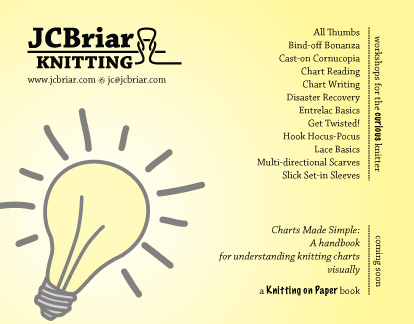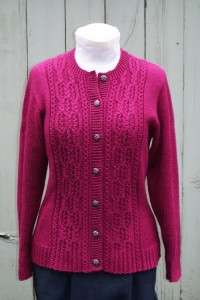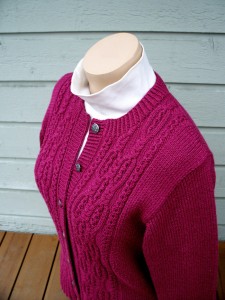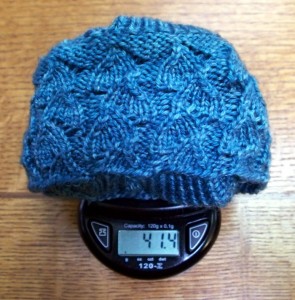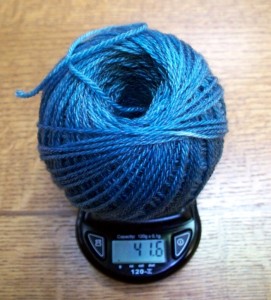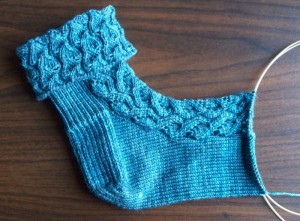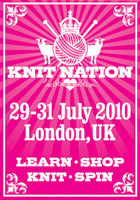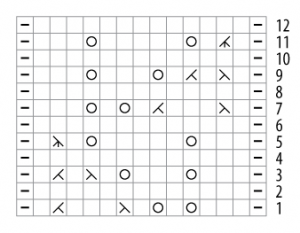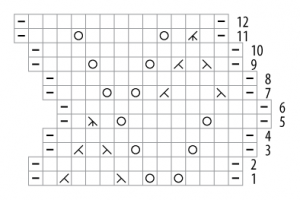Okay, I admit it: I fibbed yesterday when I said I finally managed to get Camille on Patternfish because I had gotten Yachats out of the way. No, truth be told, it was an example of work avoidance as a productivity tool.
Maybe you’ve done this too, once or twice. Maybe, when faced with a to-do list full of icky tasks, you chose to ignore them all in favor of something else, something slightly less icky. You know, like cleaning the bathroom. The to-do list is still staring you in the face—that’s your work avoidance. But at least the bathroom’s clean—that’s your productivity.
This isn’t to say that posting a pattern on Patternfish is as icky as cleaning the bathroom—far from it! The point is that it’s a good deal less icky than the other things on my to-do list. Or, I should say, the other Thing, with a capital T.
This other Thing is a book. I’ve been working on it for… oh, longer than I care to admit. Some of you got to hear about it at Stitches South, at the Teachers à la Carte luncheon, where I passed out these postcards:
See the “coming soon” part at the bottom? Charts Made Simple: A handbook for understanding knitting charts visually. Geared as an in-your-knitting-bag version of my Chart Reading class, the book’s first two chapters get you started with charts:
- The Big Picture sheds light on why charts are drawn to resemble knitted fabric, and how this governs the way you read charts.
- Staying on track suggests strategies for keeping your place within a chart, and for knitting according to a chart with a minimum of goofs.
Four more chapters dive into greater detail:
- Cable symbol sensibility introduces you to the dazzling realm of cable symbols, and shows how you can unscramble them without always running to a chart’s key for help.
- Charts that show shape explores the idiosyncrasies of charts shaped to match garment pieces, such as shaping implied via chart outlines only, multiple outlines for multiple sizes, and pivot stitches.
- Counting stitches dispels the notion that counting chart squares is the same as counting stitches, pointing out that paying attention to the symbols within the squares is the secret to figuring out how many stitches you ought to have on your needles.
- Repeated stitches draws parallels between the * and [] of written instructions and the repeat lines, boxes, or brackets of charted instructions, explaining how to work repeated stitch patterns flat and in the round.
At this point, I’ve nearly completed a rough draft. Ninety percent of the work is done; 90% of the effort is behind me. But, as the joke goes, that last 10% of the work is going to require another 90% of the effort.
Or so it seems, anyway. My to-do list includes completing a handful of illustrations, re-working a few sections for clarity and consistency, finessing and (if necessary) re-working the layout, getting the book tech-edited, and fixing the gaffes the tech editor discovers.
Oh, and since I plan to self-publish (yes, I’m a glutton for punishment), the to-do list also includes choosing a printer, making umpteen print choices (trim size, cover weight, paper weight, paper finish, binding… shall I go on?), setting up relationships with distributors, and marketing. These tasks, being new to me, qualify as extra-icky.
You get the idea. Posting Camille on Patternfish was a way of feeling productive while avoiding The Book. But that sort of productivity can’t go on a whole lot longer. I’m scheduled to hand the book over to a tech editor in mid-August. I’ve got to get crackin’ to get it ready by then.
Just after I finish cleaning the bathroom.
Camille
By JC | May 31, 2010
Finishing up the Yachats pattern (and a stealth project before that) freed up some time to get back to a long-neglected project: Camille.
Actually, I finished Camille some time ago… let’s see, must’ve been fall of 2007, as the pattern was initially published in the Spring 2008 issue of Twists and Turns. It includes some of my favorite design features: seamless construction; set-in sleeves worked from the top down with short-rowed sleeve caps; subtle waist shaping; and cables that blend in with the bottom ribbing.
But today I finally got around to making Camille available via Patternfish… like I had hoped to do months ago.
You see, back in January I decided to go through my collection of patterns, figure out for which ones I still held the copyright, and post one a week to Patternfish. I was surprised by how many patterns I’d written up over the years: hats, mittens, shawls, sweaters, and more. The “gotcha!” was that they had all been written up in different styles, for different publications. Getting a cohesive “look” to my patterns on Patternfish would entail reformatting the patterns and, in some cases, taking new sample photos. Not too taxing, really. It seemed reasonable enough to assume I could reformat a pattern each week, in my spare time.
Then February hit. I was on the road over half the month. And one excuse led to another, and here we are practically in June.
At any rate, Camille is now available. (Or should be, very shortly, once the folks at Patternfish complete some behind-the-scenes fiddling.) Will I manage to revive my Patternfish efforts, and post another pattern each week? Maybe. But don’t hold me to it, okay?
Yachats
By JC | May 26, 2010
Hot off the needles: the Yachats socks.
To finish the second sock, I did have to unravel a smidge of my swatch. I didn’t measure at the time, but it must’ve been less than a yard’s worth of yarn. Had I known, of course I would’ve knit the swatch shorter… oh, well.
I like how the socks turned out. I’d never done a round toe before—or if I had, I don’t remember it, it’s been that long—and it fits better than I expected. I’ll have to try using round toes again sometime.
So the socks are done, the photography is done, and the pattern is written. All that remains is to get word back from the tech editor on whether I flubbed up the pattern in any way.
Want the pattern? It’ll be available from the Dye Dreams Four Seasons Sock Club soon!
Whew!
By JC | May 20, 2010
Talk about close! 41.4g required for the first sock; 41.6g remaining for the second sock. ’Course, I can always unravel my swatch if I need a few more yards. And the size of the swatch (16.4g) leads me to believe knitters will have enough yarn to knit size large socks, even though I’m knitting the size medium.
Whew!
Remember the stealth knitting project that I mentioned before Stitches South? It finally went off into the mail early last week, giving me time to turn to another, long-neglected project: the Dye Dreams socks. I’m happy to report significant progress in a week’s time.
You can see that I decided to go with the fold-over cuff idea, with Little Waves on the cuff and Rivulets flowing below on the instep. Twisted rib on the back of the leg gives a nice, snug fit. The toe is as yet undecided, though—rather than a plain, standard wedge toe, I’m toying with something that might resemble pebbles on a beach, in keeping with the socks’ theme.
You know what else is undecided? The name for this sock design. I’m considering Yachats, after a town on the Oregon coast. I did a lot of the socks’ initial swatching and planning while DH (Da Hubster) and I were there last March, celebrating our anniversary. We stayed in a cute, 4-unit motel overlooking the bay where the Yachats river runs into the Pacific. As the tide recedes and the river meanders across a wide bed of sand, incredible patterns are formed in the sand. It’s too much fun to wander around at low tide, admiring the sinuous shapes as they repeat and morph from one spot to the next. They’re all the more stunning because you know they’re transient, doomed to disappear as the tide returns.
The only catch is that I suspect no-one outside Oregon would know how to pronounce “Yachats.” What’s your guess?
Knit Nation
By JC | May 13, 2010
Have you heard about Knit Nation?
Like the sign says, “Learn, shop, knit, spin!” The more I think about it, the more thrilled I am to be taking part.
- It’s in London, for cryin’ out loud! How fun will that be? I’m seriously looking forward to sneaking off to the V&A.
- I’m teaching six of my favorite classes. Cast-on Cornucopia has even sold out already! That should be a high-energy class. (Ooh, note to self: be prepared for UK knitters that typically hold the ball yarn in the right hand when casting on. For those cast-ons where US knitters normally hold two strands in the left hand, in the “slingshot” position, I ought to practice variations with tail yarn in left hand and ball yarn in right hand.)
- I get to hobnob with some really cool knitters. Many of the teachers I already know; the others I’m looking forward to meeting. And the students? It’ll be a blast to meet them too. I’m tickled by the regional differences I see here in knitting groups within the US; can you imagine what it’ll be like across The Pond?
- Did you look at the vendor list? Screw the yarn diet; how much will I be able to shove into my suitcases?
Read more about it at the Knit Nation website. And be sure to check out their blog—it features interviews with the teachers, and today’s my day.
Checklists
By JC | May 10, 2010
Yes, yes, I know this is a knitting blog. Bear with me for a minute.
I’m currently reading The Checklist Manifesto: How to Get Things Right. It’s the third of three fabulous books by author Atul Gawande, a surgeon. His previous books, Better and Complications, explore the question of why things go wrong, despite the extensive training and best efforts of the people involved. The Checklist Manifesto takes the next step, and explores a simple tool for managing complex tasks and minimizing goofs: checklists.
Used in airplane cockpits, on construction sites, and—increasingly—in hospitals, a good checklist is a short list of must-do tasks that even the most experienced people occasionally forget to perform. Each task is stated clearly and succinctly. By acting as a series of quick reminders—not as a comprehensive set of how-to instructions—the checklist greatly increases the likelihood of quality output.
Here’s where we get back to knitting.
Until recently, I used to do a fair amount of work as a tech editor, reviewing patterns and books to ensure they were clear, concise, consistent, complete, and correct. I never used a formal checklist. Oh, sure, sometimes I’d have on hand a style guide, a document explaining how the patterns were to be presented: with what punctuation and phrasing, in what sections, with what goals, etc. I would refer back to the style guide when I needed to remember, say, whether the client preferred “needles” or “ndls.” And I had mental checklists, slightly different for each client, with tasks like “check abbreviations list” and “ensure stitch counts are multiple of stitch pattern.” But who’s to say I didn’t miss a step, here and there?
I’m a big believer in style guides. (The one I use for my own patterns is currently four pages long.) But now I’m thinking checklists would be a dandy idea too.
A few weeks back, I posted a couple charts for a lace edging. Both had a zig-zag left selvedge (just like the edging), to account for the change in stitch count from row to row. But one also included “no stitch” symbols, so the symbols in the chart could line up vertical like the stitches in the knit edging. No surprise: most people preferred the second chart, despite its “no stitch” symbols, since it more closely resembled the knit edging.
Here’s another pair of charts, and a similar issue. (The key, as before, is here.)
Remember the rivulets swatch? The stitch pattern is of constant width—that is, its stitch count doesn’t change—and so it would typically be charted like this:
But the stitch pattern is so lovely in large part because it sways; it practically shimmies. Redrawing the chart makes this undulation apparent:
Bonus: this second chart also arranges the yarn overs and decreases as they appear in the knit swatch.
You’ve probably already guessed I prefer this second chart. I figure it’s clearer. Don’t you agree?
So I wonder why we don’t see more charts presented this way. Rivulets isn’t the only stitch pattern with wavy selvedges. The Gumdrops socks that I designed for Blue Moon Fiber Arts Rockin’ Sock Club feature a stitch pattern with wavy selvedges, and the leg chart in that pattern has wavy edges. As I recall, no-one in the RSC had a problem with that chart.
For wavy-edged stitch patterns, why do we see so many straight-edged charts? Or am I imagining things—do books or other publications that I’m unaware of use wavy-edged charts?
I got up at 5am this morning. I don’t normally do that, but I had to be on the road early today: Stitches South begins tomorrow in Atlanta, and I get to spend the day traveling across the country.
Oh, the joys! A two-hour drive to the airport. Paying $25 to check a bag full of essential class samples. Airport food. Waiting for a shuttle to the hotel.
On the bright side, my knitting made it through security without a blip. And so I get to spend the day working on a stealth project. Wa-hoo! 🙂
For four years now, I’ve been drawing all my charts, schematics, and diagrams in Adobe Illustrator. It ain’t cheap, but it’s worth it: Illustrator produces publication-quality vector graphics (no jaggies from low-res bitmap graphics), and gives me complete control over every aspect of the final illustrations (yes, I might be a bit of a control freak, at least when it comes to my illustrations). And, once you learn your way around, it’s a lot of fun. You never know what cool little feature you might find, hiding out in a corner you’ve never checked into before.
Case in point:
You can move the current selection by dragging it with the cursor—even Illustrator novices figure that out pretty quick. Or you can move it by pressing an arrow key on the keyboard. That’s especially handy when you have Snap to Grid turn on—for example, when drawing charts: Need to nudge a symbol over by one chart square? Just press an arrow key, and it’ll snap into place.
And you can copy the current selection by holding down the Option key as you drag (on a Mac, please—don’t ask me about the PC equivalent). But it only last week that I realized you could copy the current selection by holding down the Option key as you pressed an arrow key.
Oh, why had that cool little feature been hiding from me for so long? It’s exceptionally handy when drawing charts. Picture this: you want to draw a row of purl symbols. Plop one into the row’s leftmost chart square. Select the symbol. Now hold down the Option key and repeatedly press the right arrow key. Presto! A row of purl symbols. Or a column, or a bunch of rows or columns, or whatever, all in less time than it takes to read this paragraph.
sigh
Yes, I’m easily amused. And I wonder what other Illustrator tricks still await discovery.



